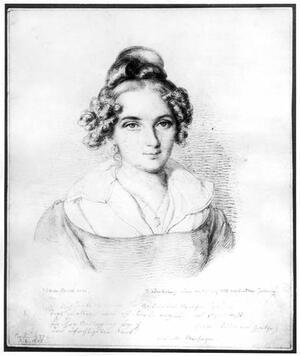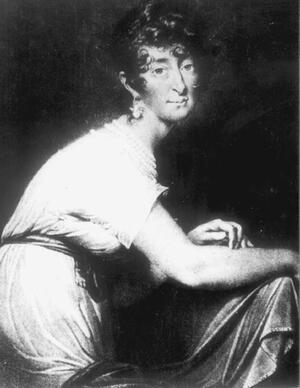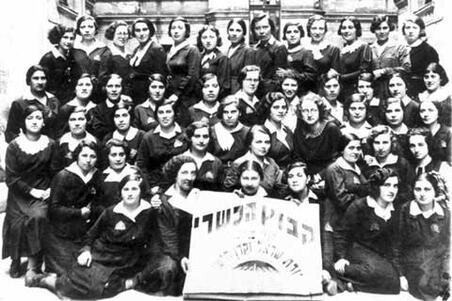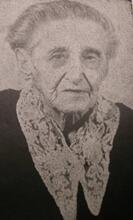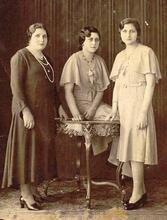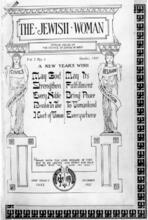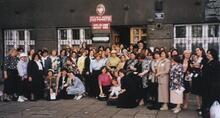Habsburg Monarchy: Nineteenth to Twentieth Centuries
Jewish women in the Habsburg Monarchy experienced the stresses and strains of nineteenth- and twentieth-century Jewish life as Jews, as women of their particular social classes, and as inhabitants of the different regions of the Monarchy. In some regions, they modernized and acculturated, but the overwhelming majority remained deeply pious, traditional Jews. A tiny minority became famous “salon Jewesses” in the early nineteenth century, while ordinary Jewish women helped their families integrate into Austro-Hungarian society and remain devoted to the Jewish community. Jewish women experienced changes in their education and their roles in religious life over the course of the period.
Introduction
The experience of Jewish women under the Habsburg Monarchy differed greatly according to the part of this large and extremely diverse country in which they lived. The Habsburg Monarchy was a dynastic state, whose territory had been acquired over many centuries and whose inhabitants spoke a wide array of languages, practiced many different religions, and constructed many different ethnic, national, and cultural identities in the nineteenth and twentieth centuries. Habsburg territory included the Habsburg hereditary lands (roughly present-day Austria), where most people spoke German, and the provinces of Bohemia and Moravia (present-day Czech Republic), acquired during the wars of religion in the sixteenth century, whose inhabitants spoke Czech and German. Virtually all the people in these regions were Roman Catholics. In the seventeenth century, the Kingdom of Hungary, which also included Slovakia, Croatia, and Transylvania, joined the Monarchy. Its inhabitants spoke many languages—Magyar, German, Slovak, Croatian, Serbian, Slovene, Ukrainian, Romanian, and Yiddish—and most of them practiced the Catholic, Lutheran, Calvinist, and Orthodox faiths. Habsburg territory also included parts of northern Italy, as well as the provinces of Galicia and Bukovina, obtained through the partitions of Poland in the eighteenth century. Here the inhabitants spoke Polish, Ukrainian, and Yiddish and were either Catholics, Uniates (Orthodox Christians who followed the Pope in Rome), or Jews. In each of these regions Jews had different historical experiences, faced divergent demands made by the local populations in whose midst they lived, and accommodated to modernity in a different manner.
Jewish women experienced the stresses and strains of nineteenth- and twentieth-century Jewish life as Jews, as women of their particular social classes, and as inhabitants of the different regions of the Monarchy. They certainly shared legal status with all Jews, suffering traditional anti-Jewish economic and residential restrictions until Joseph II lifted some of them in his famous Edicts of Toleration in the 1780s and enjoying civil, legal, and political equality after the Austrian and Hungarian governments extended full emancipation in 1867. Yet as women they did not have access to higher education until the turn of the twentieth century, nor did they have the right to vote and participate in the political process until after World War I. They could not even join political organizations until 1908. Like all Jews, they suffered from widespread antisemitism, especially in the late nineteenth century and at the end of World War I, but given their different status in the public sphere they may have experienced antisemitism differently from men.
Like their male counterparts, Jewish women in some regions of the Monarchy—especially in Bohemia, Moravia, Vienna, and parts of Hungary, especially Budapest—modernized in the nineteenth century, adopting the languages, cultures, and social mores of the peoples in whose midst they lived, abandoning some or most of the rules and regulations of traditional Judaism, and attempting to become integrated members of their societies. As women, however, they probably remained more fully enmeshed in a Jewish social universe, socializing mostly with other Jews and adhering to Jewish tradition longer than their male relatives. Other Jewish women—the overwhelming majority of Habsburg Jewish women—remained deeply pious, traditional Jews just like the overwhelming majority of Jewish men. Over three-quarters of all Habsburg Jews lived in Galicia, Bukovina, and Hungary, the regions in which most Jews, despite legal equality, remained enmeshed in the traditional Jewish community, often as disciples of one or another hasidic rebbe. In this world, women experienced life from a different vantage point than men.
Population Movements
At the end of the eighteenth century approximately 338,000 Jews lived in the Habsburg Monarchy out of a total population of almost nineteen million. The population grew enormously in the following decades, largely by natural increase, so that by 1857 there were over one million Jews in the Austrian Empire, including 86,000 in Bohemia, 42,000 in Moravia, 478,000 in Galicia and Bukovina, and 407,000 in the Kingdom of Hungary. The population continued to expand: on the eve of World War I, over two million Jews lived in the Habsburg Monarchy (or Austria-Hungary, as it was called after 1867), 932,000 in the Kingdom of Hungary and over 1,300,000 in the Austrian “half” of the Monarchy (that is, all the Habsburg territories except Hungary). Jews constituted about 4.5 percent of the total population of the Habsburg Monarchy, but in Galicia they formed eleven percent of the population and in Bukovina, thirteen percent. After the Revolution of 1848, and especially after all restrictions on freedom of movement were lifted in the 1860s, Jews from all regions of the Monarchy migrated to the cities, most of which had long been closed to Jews, and especially to the capitals, Vienna and Budapest. In the early nineteenth century, only a handful of extremely wealthy Jews resided in Vienna—those who could afford the exorbitant fees for the right of “toleration” in the city. By 1869, the city had 40,000 Jewish inhabitants; by 1890, 118,000; and by 1910, 175,000, or nine percent of a total population of just over two million. Budapest’s Jewish population grew at a similar rate but formed a larger proportion of the urban population. In 1880, the city had 70,000 Jews who formed twenty percent of the population; by World War I almost 200,000 Jews lived in the city, constituting a quarter of the total population.
Like Jewish men, Jewish women migrated in the nineteenth century, leaving their hometowns for better opportunities in the cities. Yet the statistics reveal that Jewish women followed a different migratory path from either gentile women or Jewish men, choosing far less often to move to Vienna. Gentile women migrated to the capital in large numbers, largely to work as domestic servants or factory workers, careers rarely pursued by Jewish women in nineteenth-century Central Europe. As a result of a lower rate of female Jewish migration to Vienna, there were more Jewish men in the capital than women, the opposite of the typical situation in which there are more women than men because of greater female longevity. In the late nineteenth century, there were 1,042 Jewish women for every 1000 Jewish men within Austria as a whole. But in Vienna in the same period, there were only 950 Jewish women for every 1000 Jewish men. The imbalance between Jewish men and women was far worse at the beginning of the period of migration. In 1869, when most of the Jews who migrated to Vienna came from Bohemia, Moravia, and Hungary, there were only 770 Jewish women for every 1000 Jewish men in the city. By the eve of World War I, after a large number of very poor Jews from Galicia had streamed into the capital, the male/female imbalance was not as great.
"Tolerated" Jews and Salon Jewesses: The Case of Vienna
In the early nineteenth century, Jews could not live in Vienna unless they purchased the right of toleration for a very large sum of money. In 1829 135 “tolerated” Jews lived in Vienna, mostly wealthy bankers and merchants, along with their families, employees, servants, and assorted hangers-on. In the list of seventy-one of these tolerated Jews who signed the new synagogue statutes in that year, there were six women, nine percent of the total. These women—Elisabeth Suchrovsky, Magdalena Leidesdorff, Amalia Kohn, Rosalia Levi, Rosalie Trebisch, and Julie Landauer—were all widows of tolerated Jews who carried on their husbands’ businesses and, as heads of their wealthy families, had rights and status within the Jewish community. With the exception of Rosalia Levi, they could sign their names in Latin letters, a reflection of the fact that they had received at least some secular education.
More famous than these women were Fanny Arnstein and Cäcilie Eskeles, the wives of two of Vienna’s leading Jewish bankers, Nathan Arnstein and Bernhard Eskeles, both ennobled by the Habsburgs for their services to the crown. Fanny and Cäcilie were sisters, the daughters of the wealthy Jewish banker Daniel Itzig of Berlin. In Vienna they both hosted literary salons on the model of those hosted by their sisters, cousins, and friends in late eighteenth-century Berlin. The Berlin “salon Jewesses,” wealthy, intellectual Jewish women with secular education, including Rahel Varnhagen, Henriette Herz, and Dorothea Mendelssohn Veit (von Schlegel), had participated in the highest reaches of Berlin’s Enlightenment intellectual circles, befriending (and sometimes marrying) aristocrats who found them exotic and alluring. For a few decades in Berlin, before the Prussian defeat by France in 1806 changed the complexion of intellectual life there, a small group of educated Jewish women managed to participate in the city’s culture and high society, an extraordinary feat given anti-Jewish restrictions, lack of equal rights, and a rigid, caste-conscious society.
Fanny Arnstein and Cäcilie Eskeles attempted to do the same in early nineteenth-century Vienna, inviting aristocrats into their homes for literary—and political—conversation, a task made easier by the fact that many Prussian aristocrats, already comfortable in Jewish salons, came to Vienna after Prussia’s defeat in 1806. During the Congress of Vienna in 1815, Arnstein tried to use her influence in her salon to persuade Austrian and Prussian nobles in attendance to grant Jews equal rights. Since her influence was severely limited, she was not successful. Arnstein played a role in Viennese cultural life beyond her salon, helping to found the “Society of the Friends of Music,” which organized public classical music concerts. Here she had the unusual opportunity of socializing with aristocratic women, who generally did not attend salons. Historians have been divided on whether she, like many of the Berlin salon Jewesses, converted to Christianity. A study by Anna L. Staudacher of Jews who were baptized in Vienna between 1782 and 1868 reveals that Arnstein served as honorary godmother in the Calvinist Church for the niece of one of her servants in 1804, a role she could not normally have played as a professing Jew. In this case, however, the pastor must have made an exception because the real godmother was her proxy—the child’s aunt. Given the fact that Arnstein was buried in a Jewish cemetery, it is unlikely that she converted. Fanny von Arnstein’s daughter, Henriette von Pereira-Arnstein, was, however, baptized. As in Berlin, the Vienna Jewish salons faded from view as new intellectual and political currents in the 1820s and 1830s made gentiles once again shun socializing with Jews.
At the same time as these wealthy women attempted to integrate into Viennese society, many poor Jewish women migrated to the city to work as domestic servants or seamstresses. They achieved a far higher level of social integration, working and living with gentiles, bearing their children, and frequently converting to Christianity in order to remain in the city or marry the fathers of their children.
The Impact of Emancipation and Embourgeoisement
The end of anti-Jewish restrictions in the nineteenth century—including the onerous restrictions in Bohemia and Moravia on the number of Jews who were permitted to marry—and the granting to the Jews of legal equality in 1867 allowed many Jewish men to abandon traditional Jewish occupations in petty trade and to pursue more lucrative careers in commerce, industry, and the professions. The increase in Jewish wealth and respectability was especially marked in the richer regions of the Monarchy: Vienna, Budapest, and Prague, and the industrialized regions of Bohemia, Moravia, and parts of Hungary. Among the first generations of Jews who entered the middle and upper middle class in the early and mid-nineteenth century, women often participated in developing their family’s businesses. However, by the late nineteenth century they and their families had internalized the prevalent cult of female domesticity. Bourgeois Jewish women thus stayed home, saw to it that they raised well-behaved and properly cultivated children, and tastefully displayed the newly won wealth and status of their husbands. Like middle-class Jewish women in Germany, they assisted in the acculturation of their families to the social and cultural norms of the society in which they lived, although the multinational, multiethnic, and multilingual situation in Austria-Hungary made it difficult to decide to which group they would acculturate.
Naturally, the Jews who migrated to Vienna adopted German culture if they had not already done so at home. In Hungary, most middle-class Jews opted for German culture in the early nineteenth century, but rising Hungarian nationalism convinced them to become staunch Hungarian patriots and to adopt Magyar language and culture by the last third of the century. In Bohemia and Moravia, the Jews had already Germanized by the 1840s. While some, especially in Bohemia, responded to Czech nationalist pressure and adopted a Czech identity, most Jews retained their German cultural loyalties. In Galicia, where most Jews remained poor, devoted to traditional Judaism, and Yiddish-speaking, the middle classes spoke both German and, by the last decades of the nineteenth century, Polish. Bourgeois Jewish women in all these regions thus ensured that their children became proper German, Hungarian, Czech, or Polish children. At the same time, they also perpetuated the Jewish identities of their children and socialized almost entirely with other Jews. Persistent antisemitism in all regions of the Monarchy made it difficult for Jews and gentiles to socialize, and the family-centered nature of Jewish women’s lives virtually guaranteed a Jewish social universe for them and for the rest of their families, whose social lives they orchestrated.
Bourgeois Jewish women did find one important outlet for sociability outside the family. In the nineteenth century they created a wide range of Jewish women’s organizations, mostly for charitable purposes, which provided an acceptable venue for women in the public arena. In Vienna the first Jewish women’s organization, the Israelitische Frauenwohltätigkeitsverein (Israelite Women’s Philanthropic Organization), formed in 1816, saw its mission as helping women in need, especially the elderly, the sick, women in childbed, and those abandoned by their husbands. The clientèle may have been poor, but the activists were the wives, sisters, and daughters of Vienna’s richest men. When the organization celebrated its centennial in 1916, its officers included Charlotte von Königswarter, Bettina von Rothschild, and Sofie von Todesco, all members of Vienna’s Jewish wealthy, ennobled upper crust. In the second half of the nineteenth century, especially the 1880s and 1890s, when rising antisemitism virtually precluded the possibility of Jewish women joining organizations with substantial gentile membership, the number of Jewish women’s organizations proliferated everywhere, providing Jewish women with the opportunity to fulfill simultaneously the demands of bourgeois domesticity and of Jewish tradition to help the poor, while also enabling Jewish women to socialize with each other. Some of these organizations were the preserve of the rich; others of the more ordinary middle class. Many were quite large. The Leopoldstadt Israelite Women’s Philanthropic Organization, organized in 1897 in Vienna’s second district, had 800 members. Most of these organizations focused on the needs of poor Jewish women and children, providing them with food, day-care centers, orphan asylums and dormitories, baby care advice, clothing, vocational training, medical assistance, and money. Jewish women also organized for intellectual and quasi-political purposes, forming literary societies like Moriah in Vienna, to study Jewish history and literature, and Zionist organizations [link to new entry on Women and Zionism in Poland] like Miriam and Hadassah to participate in the newly formed movement to create a Jewish state.
Jewish women’s organizational efforts reached their peak during World War I. Middle-class Jewish women all over the Habsburg Monarchy participated actively on the home front, donating their time and their money to help soldiers, their widows and orphans, and the large number of people impoverished by a long, bloody war. Although initially intent on helping all victims of Austria’s war regardless of religion or ethnic attachment, the primary focus of Jewish women’s charitable work during the war very quickly became fellow Jews in distress. They worked valiantly to attend to the needs of Jewish soldiers, sending them books, religious supplies and Lit. "dedication." The 8-day "Festival of Lights" celebrated beginning on the 25th day of the Hebrew month of Kislev to commemorate the victory of the Jews over the Seleucid army in 164 B.C.E., the re-purification of the Temple and the miraculous eight days the Temple candelabrum remained lit from one cruse of undefiled oil which would have been enough to keep it burning for only one day.Hanukkah packages and providing them with Term used for ritually untainted food according to the laws of Kashrut (Jewish dietary laws).kosher food, especially for A seven-day festival to commemorate the Exodus from Egypt (eight days outside Israel) beginning on the 15th day of the Hebrew month of Nissan. Also called the "Festival of Mazzot"; the "Festival of Spring"; Pesah.Passover and other Jewish holidays.
More importantly, Jewish women mobilized to assist the hundreds of thousands of Jewish refugees who fled from Galicia and Bukovina in 1914 and again in 1916 fearing for their lives when the Russian army invaded those provinces. Most of the refugees—a disproportionate number of whom were women and children—streamed into Bohemia, Moravia, Hungary, and Vienna. The financial support the government provided to these war victims was woefully inadequate, and conditions were terrible in the large internment camps built to house many of them. Jews, especially Jewish women, organized to help the refugees, providing them with money, clothing, housing, medical care, advice, education, and synagogue services. Frequently this assistance was accompanied by a sense of cultural superiority and condescension on the part of the “Western” Jews toward “Eastern” Jews. Nevertheless, the fact that Jewish women focused on the needs of other Jews at a time of rising antisemitism increased their sense of Jewish solidarity. Since they perceived their work as part of the Austrian war effort, their work on behalf of Jewish soldiers and suffering Galician Jewish refugees also augmented their loyalty to the Habsburg Monarchy. They feared the possible dissolution of the Monarchy and worried that Galician refugees returning to a future independent Poland would suffer from antisemitism unchecked by judicious Habsburg officials.
The woman most widely known for her activities on behalf of Galician Jewish refugees was the young Viennese Zionist activist, Anitta Müller. Seeing her primary clientèle as refugee mothers and children, Müller created a number of institutions to help them, including a maternity hospital and home for new mothers, a baby-care center, day-care centers, and schools to teach adolescent girls a trade. In addition, she opened a “tea and soup institute” that sold tea and soup at nominal prices to thousands of refugees every day, providing them with a pleasant space in which to eat, read the newspapers, and socialize with each other. By the end of the war Müller’s umbrella organization, the Verein sociale Hilfsgemeinschaft Anitta Müller, had assisted thousands of needy Galician refugees. Moreover, by providing employment for many Viennese and refugee women, her institutions helped professionalize social work in Austria. The Jewish community at large applauded Müller’s efforts. The Oesterreichische Wochenschrift, a liberal Jewish newspaper in Vienna, praised her as “a model for Jewish women in our time.” After the war Müller continued her efforts on behalf of poor Jewish women and children at the same time as she pursued a political career, winning a seat on the Vienna City Council in 1919. Always a committed Zionist, she moved to Palestine in 1936, creating institutions there to help mothers and their children.
Religion and Education
The position of women in Jewish religious life did not change greatly in the Habsburg Monarchy in the nineteenth and twentieth centuries. Although a radical reform movement did emerge in Budapest and a few other cities in Hungary in the 1840s, modernizing Habsburg Jews in general eschewed religious reform on the German model, preferring instead a modernized, traditional Judaism, the so-called “Vienna Rite,” which retained the traditional Jewish liturgy in Hebrew but included a vernacular sermon delivered by a modern, university-educated rabbi, a male choir, and order and decorum. Even in Hungary radical reform was rare; most modern Jews affiliated with the “Neolog” movement, which retained a largely traditional Jewish religious service accompanied by organ music. Both the Neologs and those who followed the Vienna Rite made few changes in the role of women in Judaism. In modernized synagogues all over the Monarchy, women sat in women’s galleries, which were often covered with latticework. Vienna’s rabbis did institute confirmation for Jewish girls, but it is not clear whether many Jewish girls were actually confirmed. Adolf Jellinek (1820/21–1893), the reform-minded rabbi from 1858 to 1893, hoped to ease some of the burdens of Jewish law for women by ignoring the laws of halitzah (the ceremony performed when a man refuses to marry his brother’s childless widow), but, like most Reform rabbis (and everyone else), he held conventional ideas about the role of women in Judaism. Most Jewish women in the Habsburg Monarchy lived in the traditional hasidic or non-hasidic orthodox communities of Galicia, Bukovina, and Hungary, where they continued to enjoy the traditional status of Jewish women.
Increasingly, however, Jewish women were able to receive secular and religious education, although that education remained inferior to the education of boys. Among the modernizing Jews of the Monarchy, traditional Jewish education for boys declined in the nineteenth century as Jews increasingly obtained a secular education, first at modern Jewish schools and later in the public schools. In Bohemia and Moravia in particular, modern Jewish primary schools became widespread after Joseph II’s Edict of Toleration of 1781–1782; they offered a full curriculum of secular studies with German as the language of instruction. Girls also attended these schools, receiving a solid German primary education there. The schools succeeded in Bohemia and Moravia because, in deference to the fears of the traditional religious establishment, they did not teach Jewish subjects at all for the first several decades, leaving that arena to the traditional Lit. "room." Old-style Jewish elementary school.heder, which boys could continue to attend. By the mid-nineteenth century, the German-Jewish schools did teach Hebrew, Bible, and Jewish prayer to boys and girls alike, usually for six to ten hours a week. By the late nineteenth century, many Jews attended the public schools, where they received two hours of officially mandated religious instruction a week. The curriculum, provided by local Jewish communities, was perforce skimpy, restricted for boys to Bible stories, Jewish history, reading and translation of prayers, Jewish religious principles, and selected readings in the Hebrew Bible. Girls followed the same curriculum, with the important exception that they did not learn how to read the Bible in Hebrew, presumably because knowledge of the Hebrew Bible was deemed unnecessary for girls.
In Galicia and Hungary, traditionalist Jews, allied with local aristocrats who resented Viennese demands of any sort, sabotaged government efforts to create a modern Jewish school system in the late eighteenth and early nineteenth century, and traditional Jewish educational practices persisted. The majority of deeply pious Jews in these regions sent their sons to heder and educated their daughters at home if at all. Yet, because Habsburg Austria mandated elementary school education for all, many religious Jews in Galicia, less concerned about female education, sent their daughters (but not their sons) to public school, where they learned Polish language, literature, and history. As a result, Jewish girls far outstripped Jewish boys in attending such schools. In 1900, fully 60% of all Jewish girls in Galicia attended public school, while only 45% of all Jewish boys did so. By the late nineteenth century, Galicia was home to large numbers of religious Jewish girls whose education made them want to break free of the constraints of the traditional Jewish community. Responding to the crisis of Jewish girls who converted to Christianity to evade arranged marriages, Sarah Schenirer of Kraków, herself an Orthodox Jew who had attended a Polish school, recognized that the problem was the absence of a thorough Jewish education for girls. In the early twentieth century, she created schools for Jewish girls in Galicia that would teach them Hebrew, Jewish religious texts, and some secular subjects. Her primary goal was to instill in Jewish girls enthusiasm for traditional Judaism. Many religious leaders in Galicia opposed schooling for girls, but Schnirer and her allies in the religious establishment succeeded in establishing the Bais Ya’akov network of schools in the 1920s. On the eve of World War I, the majority of Jewish women in the Monarchy had received at least a primary secular education.
Within the Habsburg Monarchy many Jews took advantage of the opportunity to obtain higher education, but both the high schools and the universities remained closed to women until the early twentieth century. Girls interested in education beyond primary school could attend a private middle school for girls, usually called a Mädchenlyzeum, which offered an education far inferior to that offered boys in the academic Gymnasium or the more technically oriented Realschule. In the Mädchenlyzeum, girls studied history, literature, and modern languages, but not the Latin, Greek, mathematics, and science offered to boys in their schools and required for university attendance. Moreover, female education was decidedly inferior, far less academically rigorous, and included such non-academic “feminine arts” as needlework. While boys in an academic Gymnasium did eight years of Latin and five of Greek, girls wrote compositions on “The Advantages of Country Life” or “An Unlikely Summer Journey.” Nevertheless, many Jews wanted to educate their daughters, and Jewish girls formed the overwhelming majority of students in many Mädchenlyzeen. Jews in general were over-represented in high schools in the regions in which they lived, but Jewish women almost entirely dominated high schools for girls. In Vienna, for example, a city whose Jews formed nine percent of the total urban population, about a third of all Gymnasium students were Jews, but forty-six percent of all pupils in Mädchenlyzeen were Jewish. In some schools, Jews formed almost the entire student body: in the school run by Eugenie Schwarzwald, Jews were seventy percent of all students, while in the schools run by Amalia Sobel and Olga Ehrenhaft-Steindler, Jews were eighty-eight percent of all students. Jewish girls also formed forty-three percent of the students in the school run by the Society for Expanding Women’s Education, which offered a full Gymnasium-style education for the small number of girls who sought university education once it became available.
Jewish women were disproportionately represented among the first generation of women in Austrian universities, which opened their doors to female students in philosophy and medicine in 1897 and in law only after World War I. These women, who sought intellectual fulfillment, careers, and personal liberation, often went on to prominent careers as doctors, educators, and social workers. As in Germany, persistent de facto discrimination against Jews made it very difficult for them to become teachers, and so, unlike most women who attended university to pursue a career in what was for women the socially acceptable field of education, university-educated Jewish women more commonly became doctors or private school principals. Between 1897 and 1918, forty percent of all female students in Austrian universities were Jewish. In medicine, however, fully sixty percent of all female students were Jews. Jewish men were also disproportionately represented among university students, especially in medicine and law, forming half and one third of all students in those fields. While the absolute numbers were smaller, Jews formed a larger proportion of all female students than they did of all male students.
At the university and in their future careers these women suffered from both misogyny and antisemitism. What is remarkable is how many of them became prominent professionals, especially in medicine, where they were mostly in private practice, usually treating a clientèle of women and children. A significant number, most notably Helene Deutsch, participated in Freud’s circle of psychoanalysts and became active in the new field of mental health. Some attempted a career in university teaching, but this was almost impossible for women, even for such luminaries as the physicist Lise Meitner. Other Jewish university graduates became directors of private schools, most notably Eugenie Schwarzwald, Salka Goldmann, and Lillian Stern Bader. Among those who turned to politics, especially Socialist politics, after World War I, were Käthe Leichter, who served as director of women’s affairs for the Vienna city government and worked assiduously to pass legislation to protect working women; Helene Gumplowicz Bauer, the wife of Socialist leader Otto Bauer, who worked as a journalist and member of the Vienna school board; and Ruth Fischer, a founding member of the Austrian Communist Party. Many Jewish women (fifteen to twenty percent) who attended university, especially those who sought careers in academia, converted to Christianity or to the neutral category, “without religion.” Lise Meitner was baptized, while Eugenie Schwarzwald and Käthe Leichter formally declared themselves “without religion.”
Feminism
Many Austrian Jewish women also participated actively in the Austrian feminist movement, working to improve the status of women and gain the right to vote. The most prominent Austrian Jewish suffragettes included the journalists Henriette Herzfelder, who edited the Zeitschrift für Frauenstimmrecht (Newspaper for Women’s Suffrage) from 1911–1918, Leopoldine Kulka, Ernestine von Fürth, and Olly Schwartz, who after World War I headed the bureau of vocational counseling for the city of Vienna. Numerous Jewish women involved in Jewish women’s charitable organizations also served as activists in the Federation of Austrian Women’s Organizations and the more radical General Austrian Women’s Organization and contributed to the Austrian feminist press. Ottilie Bondy was one of the founders of the Vienna Housewives Association; Regine Ulmann, the director of various Jewish women’s organizations, including the umbrella organization Weibliche Fürsorge during World War I, helped found the interreligious Women’s Organization for Social Welfare; and Anitta Müller contributed to the feminist press and served as an officer of the General Austrian Women’s Organization. Many of these women converted out of Judaism (Bondy, Herzfelder, von Fürth, and Schwarz), but others, especially Ulmann and Müller, remained committed Jews. While the Austrian feminist movement avoided antisemitic politics, one of its prominent activists, Auguste Fickert, did not want her feminist newspaper, Neues Frauenleben, to fall into “Jewish hands,” possibly out of fear that the antisemites would label feminism “Jewish.” Nevertheless, her main disciple, Leopoldine Kulka, who did not become editor of the paper after Fickert’s 1910 death, continued to write for the paper, as did many other Jewish feminists.
Although the legal status of women improved after World War I as all of the Habsburg successor states granted women the right to vote, participate in the political process, and attend university, Jewish women still faced both antisemitism and misogyny in their attempt to participate fully in the new states.
Deutsch, Helene. Confrontations with Myself. New York: W.W. Norton & Company, 1973,
Freidenreich, Harriet Pass. Female, Jewish, Educated: The Lives of Central European University Women. Bloomington, IN: Indiana University Press,2002.
Freidenreich, Harriet Pass. Jewish Politics in Vienna, 1918–1938. Bloomington, IN: Indiana University Press, 1991.
Grunwald, Max. History of Jews in Vienna. Philadelphia: Jewish Publication Society of America, 1936.
Hertz, Deborah. Jewish High Society in Old Regime Berlin. New Haven: Yale University Press, 1988.
Iggers, Wilma A. Women of Prague: Ethnic Diversity and Social Change from the Eighteenth Century to the Present. Providence, RI: Berghahn Books, 1995.
Kaplan, Marion A. The Making of the Jewish Middle Class: Women, Family, and Identity in Imperial Germany. New York: Oxford University Press, 1991.
Lachs, Minna. Warum schaust du zurück. Erinnerungen 1907–1941. Vienna: Europaverlag, 1986.
Manekin, Rachel. The Rebellion of the Daughters: Jewish Women Runaways in Habsburg Galicia. Princeton, NJ: Princeton University Press, 2020.
Mauthner, Hella Roubicek. Hella. Washington, DC: 1996.
Miller, Michael Laurence. Rabbis and Revolution: The Jews of Moravia in the Age of Emancipation. Stanford, CA: Stanford University Press, 2011.
Rozenblit, Marsha L. Reconstructing a National Identity: The Jews of Habsburg Austria during World War I. New York: Oxford University Press, 2001.
Rozenblit, Marsha L. The Jews of Vienna, 1867–1914: Assimilation and Identity. Albany, NY: SUNY Press, 1983.
Rozenblit, Marsha L. “Creating Jewish Space: German-Jewish Schools in Moravia,” Austrian History Yearbook 44 (2013): 108-147.
Spiel, Hilde. Fanny von Arnstein: A Daughter of the Enlightenment, 1758–1818. Translated by Christine Shuttleworth. New York: Berg, 1991; orig. 1978.
Staudacher, Anna L. Jüdische Konvertiten in Wien 1782–1868. Frankfurt/Main, Berlin: Peter Lang, 2002.
Steiner, Herbert, ed. Käthe Leichter: Leben und Werk. Vienna: Europa Verlag, 1973.
Wistrich, Robert S. The Jews of Vienna in the Age of Franz Joseph. Oxford: Oxford University Press, 1989.

